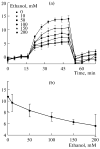[The role of the voltage-dependent anion channels in the outer membrane of mitochondria in the regulation of cellular metabolism]
- PMID: 21033348
- PMCID: PMC4547860
[The role of the voltage-dependent anion channels in the outer membrane of mitochondria in the regulation of cellular metabolism]
Abstract
The role of voltage-dependent anion channels (VDAC/porins) of the mitochondrial outer membrane in the regulation of cell metabolism is assessed using an experimental model of ethanol toxicity in cultured hepatocytes. It is demonstrated that ethanol inhibits the phosphorylating and the uncoupled mitochondrial respiration, decreases the accessibility of mitochondrial adenylate kinase in the intermembrane space, and suppresses ureagenic respiration in the cells. Treatment with digitonin at high concentrations (>80 μM)—which creates pores in the mitochondrial outer membrane, allowing bypass of closed VDAC—restores all the processes suppressed with ethanol. It is concluded that the effect of ethanol in hepatocytes leads to global loss of mitochondrial function because of closure of VDAC, which limits the free diffusion of metabolites into the intermembrane space. Our studies also reveal the role of VDAC in the regulation of liver-specific intracellular processes such as ureagenesis. The data obtained can be used in development of pharmaceuticals that would prevent VDAC closure in mitochondria of ethanol-oxidizing liver, thus protecting liver tissue from the hepatotoxic action of alcohol.
Figures






Similar articles
-
Ethanol suppresses ureagenesis in rat hepatocytes: role of acetaldehyde.J Biol Chem. 2012 Mar 2;287(10):7692-700. doi: 10.1074/jbc.M111.293399. Epub 2012 Jan 6. J Biol Chem. 2012. PMID: 22228763 Free PMC article.
-
Ethanol exposure decreases mitochondrial outer membrane permeability in cultured rat hepatocytes.Arch Biochem Biophys. 2009 Jan 15;481(2):226-33. doi: 10.1016/j.abb.2008.10.036. Epub 2008 Nov 11. Arch Biochem Biophys. 2009. PMID: 19014900 Free PMC article.
-
Phosphorothioate oligonucleotides reduce mitochondrial outer membrane permeability to ADP.Am J Physiol Cell Physiol. 2007 Apr;292(4):C1388-97. doi: 10.1152/ajpcell.00490.2006. Epub 2006 Nov 29. Am J Physiol Cell Physiol. 2007. PMID: 17135295
-
Voltage-dependent anion channel (VDAC) as mitochondrial governator--thinking outside the box.Biochim Biophys Acta. 2006 Feb;1762(2):181-90. doi: 10.1016/j.bbadis.2005.10.006. Epub 2005 Nov 4. Biochim Biophys Acta. 2006. PMID: 16307870 Review.
-
VDAC regulation: role of cytosolic proteins and mitochondrial lipids.J Bioenerg Biomembr. 2008 Jun;40(3):163-70. doi: 10.1007/s10863-008-9145-y. J Bioenerg Biomembr. 2008. PMID: 18654841 Free PMC article. Review.
Cited by
-
Targeting the Mitochondrial Protein VDAC1 as a Potential Therapeutic Strategy in ALS.Int J Mol Sci. 2022 Sep 1;23(17):9946. doi: 10.3390/ijms23179946. Int J Mol Sci. 2022. PMID: 36077343 Free PMC article.
-
Decoding Cancer through Silencing the Mitochondrial Gatekeeper VDAC1.Biomolecules. 2024 Oct 15;14(10):1304. doi: 10.3390/biom14101304. Biomolecules. 2024. PMID: 39456237 Free PMC article. Review.
-
The Mitochondrial Voltage-Dependent Anion Channel 1, Ca2+ Transport, Apoptosis, and Their Regulation.Front Oncol. 2017 Apr 10;7:60. doi: 10.3389/fonc.2017.00060. eCollection 2017. Front Oncol. 2017. PMID: 28443244 Free PMC article. Review.
-
Antifungal drug itraconazole targets VDAC1 to modulate the AMPK/mTOR signaling axis in endothelial cells.Proc Natl Acad Sci U S A. 2015 Dec 29;112(52):E7276-85. doi: 10.1073/pnas.1512867112. Epub 2015 Dec 10. Proc Natl Acad Sci U S A. 2015. PMID: 26655341 Free PMC article.
References
-
- Garcia-Rivas GJ, Torre-Amione G. Methodist DeBakey Cardiovasc J. 2009;5:2. - PubMed
-
- Kuznetsov AV, Hermann M, Saks V, Hengster P, Margreiter R. Int J Biochem Cell Biol. 2009;41:1928. - PubMed
-
- Martinelli P, Rugarli EI. Biochim Biophys Acta. 2010;1797:1. - PubMed
-
- Tylkova L. Gen Physiol Biophys. 2009;28:219. - PubMed
Publication types
MeSH terms
Substances
Grants and funding
LinkOut - more resources
Full Text Sources
